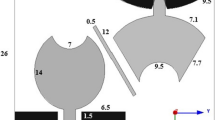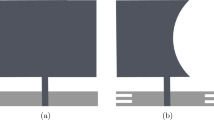Abstract
A two element Multiple Inputs Multiple Outputs (MIMO) antenna which possesses very low mutual coupling with a compact size of 0.32 \({\uplambda }_{0}\) × 0.36 \({\uplambda }_{0}\) has been proposed for wideband application. The MIMO antenna involves two antenna elements with I-shaped isolation structure between them. The antenna has achieved impedance bandwidth ranging from 3.15 GHz to 8.5 GHz which covers C-band (4–8 GHz), WLAN (5.1–5.8 GHz), ISM band (5.2/5.8 GHz) and 5G (3.3–5 GHz). The results of simulation show that the antenna has isolation greater than 20 dB throughout the operating frequency band. The antenna uses FR4 as substrate with thickness 1.6 mm. The antenna has a simple planar structure for which the design is easy with simple process involved.
Access provided by Autonomous University of Puebla. Download conference paper PDF
Similar content being viewed by others
Keywords
- Multiple inputs multiple outputs (MIMO)
- Isolation
- Industrial
- Scientific and medical (ISM)
- Wideband local area network (WLAN)
1 Introduction
In the contemporary wireless communications system, there is a need for high channel bandwidth, fast data connections, smart multimedia and improved spectrum performance. These basic needs could well be provided by MIMO antenna systems. In MIMO antenna system, the transmitter and the receiver are equipped with multiple antennas provided there is minimum coupling to achieve among the ports of antenna elements. However, it is a great challenge among the researchers to achieve very low coupling among the ports of antenna elements. Therefore, maintaining low coupling is one of the major parameters in MIMO system [1].
Nowadays, there are many techniques available to mitigate mutual coupling between antenna elements, such as etching slot on the ground structure [2], using metal strip reflector [3], adopting orthogonal mode [4], adding self-curing decoupling with capacitive loads [5] and inserting parasitic stubs between antenna elements [6]. Moreover, isolation can also be increased by incorporating defected ground plane [7], electromagnetic band gap structure [8] and maintaining suitable gaps between the antenna elements.
In this paper, a wideband MIMO antenna consisting of two antenna elements has been proposed and analyzed. The antenna occupies a compact size of \(28 \times 32 \;{\text{mm}}^{2}\) and offers broad frequency bandwidth ranging from 3.15 GHz to 8.5 GHz with good isolation.
2 Antenna Design
Figure 1 illustrates the configuration of MIMO antenna structure. The MIMO antenna has got FR4 as substrate whose dielectric constraint is \(\varepsilon_{r}\) = 4.4. It occupies a compact size of 28 × 32 \({\text{mm}}^{{2}}\) whose thickness is 1.6 mm. The proposed MIMO antenna contains two similar antenna elements separated by an I-shaped ground stub with partial ground plan. The numerical analysis of the antenna structure was performed by using Ansys electromagnetic simulation software HFSS. The final optimized numerical constraints for the proposed MIMO antenna are recorded as follows (in millimeters): W = 32 mm, L = 28 mm, \(L_{g}\) = 10.5 mm, \(w_{p}\) = 3 mm, \(w_{1}\) = 14 mm, \(w_{2}\) = 2 mm, \(w_{3}\) = 5 mm, \(w_{4}\) = 1 mm, \(w_{5}\) = 2 mm, \(w_{6}\) = 6.5 mm, \(l_{1}\) = 5 mm and \(l_{2}\) = 14.75 mm.
To study the effect of I-shaped ground stub on isolation, the current distributions are analyzed at 3.45 GHz by exciting only port 1 as depicted in Fig. 2. Figure 2a demonstrates that a strong surface current is transmitted from port 1 to port 2, due to which there is very low isolation in this case. Further, Fig. 2b shows the surface current coupling from port 1 to port 2 is found to be reduced when the I-shaped ground stub is introduced. The consequence is that high isolation has been provided between the antenna elements. The corresponding S parameters are also studied as shown in Fig. 3 in which the impedance bandwidth is found to be improved as well as the isolation (\(S_{21}\)) is enhanced by employing the I-shaped stub.
3 Results and Discussion
3.1 S Parameters
Figure 4 describes the simulated S parameters of the proposed MIMO antenna. It is seen that the MIMO antenna offers an operation bandwidth from 3.15 to 8.5 GHz for \(S_{11}\)<-10 dB. A high isolation, which is more than 20 dB over the entire frequency spectrum, is achieved.
3.2 Diversity Performance
The simulated ECC and DG curves are shown Fig. 5a, b, respectively.
The figures also show that the simulated ECC value is found to be below 0.02 which is less than the maximum acceptable ECC value of less than or equal to 0.5. Moreover, diversity gain is found to be greater than 9.95 dBi throughout the entire frequency spectrum which ranges from 3.15 to 8.5 GHz.
3.3 Radiation Characteristics
The simulated radiation patterns of the proposed MIMO antenna are analyzed by exciting only port 1. Figure 6a, b depict the radiation patterns under xoz- and yoz-planes at 3.45 GHz and 5.45 GHz, respectively. The far field radiation pattern shows that field distribution is omnidirectional at 3.45 GHz and 5.45 GHz, respectively.
4 Conclusion
The proposed work presents a compact MIMO antenna having a size of 0.32 \({\uplambda }_{0}\) × 0.36 \({\uplambda }_{0}\) for application in wideband spectrum. The operation frequency band of the antenna ranges from 3.15 to 8.5 GHz. The isolation is less than −20 dB throughout the operating band which confirms very good isolation in the MIMO system. The ECC value is found to be less than 0.02 and diversity gain is greater than 9.95 dBi throughout the band.
References
Sharawi MS (2013) Printed multi-band MIMO antenna systems and their performance metrics [wireless corner]. IEEE Anten Propag Mag 55(5):218–232
Ren J, Hu W, Yin Y, Fan R (2014) Compact printed MIMO antenna for UWB applications. IEEE Anten Wirel Propag Lett 13:1517–1520
Roshna TK, Deepak U, Sajitha VR, Vasudevan K, Mohanan P (2015) A compact UWB MIMO antenna with reflector to enhance isolation. IEEE Trans Anten Propag 63(4):1873–1877
Sun L, Feng H, Li Y, Zhang Z (2018) Compact 5G MIMO mobile phone antennas with tightly arranged orthogonal-mode pairs. IEEE Trans Anten Propag 66(11):6364–6369
Sui J, Wu KL (2018) Self-curing decoupling technique for two inverted-F antennas with capacitive loads. IEEE Trans Anten Propag 66(3):1093–1101
Liu L, Cheung SW, Yuk TI (2015) Compact MIMO antenna for portable UWB applications with band-notched characteristic. IEEE Trans Anten Propag 63(5):1917–1924
Wei K, Li JY, Wang L, Xing Z, Xu R (2016) Mutual coupling reduction of microstrip antenna array by periodic defected ground structures. In: IEEE conference on antennas and propagation (APCAP), Kaohsiung, pp 389–390
Wu W, Yuan B, Wu A (2018) A quad-element UWB-MIMO antenna with band-notch and reduced mutual coupling based on EBG structures. Int J Antennas Propag
Author information
Authors and Affiliations
Corresponding author
Editor information
Editors and Affiliations
Rights and permissions
Copyright information
© 2024 The Author(s), under exclusive license to Springer Nature Singapore Pte Ltd.
About this paper
Cite this paper
Azharuddin, M., Barik, D.K., Mondal, K., Murmu, L., Mandal, T. (2024). A Compact Dual-Element MIMO Antenna with High Isolation for Wideband Applications. In: Swain, B.P., Dixit, U.S. (eds) Recent Advances in Electrical and Electronic Engineering. ICSTE 2023. Lecture Notes in Electrical Engineering, vol 1071. Springer, Singapore. https://doi.org/10.1007/978-981-99-4713-3_21
Download citation
DOI: https://doi.org/10.1007/978-981-99-4713-3_21
Published:
Publisher Name: Springer, Singapore
Print ISBN: 978-981-99-4712-6
Online ISBN: 978-981-99-4713-3
eBook Packages: EngineeringEngineering (R0)










